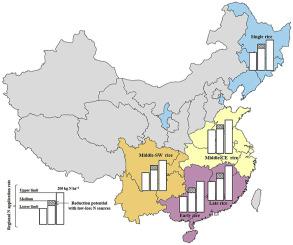当前位置:
X-MOL 学术
›
Environ. Pollut.
›
论文详情
Our official English website, www.x-mol.net, welcomes your feedback! (Note: you will need to create a separate account there.)
Estimating regional N application rates for rice in China based on target yield, indigenous N supply, and N loss.
Environmental Pollution ( IF 8.9 ) Pub Date : 2020-03-28 , DOI: 10.1016/j.envpol.2020.114408 Wencheng Ding 1 , Xinpeng Xu 2 , Ping He 2 , Jiajia Zhang 2 , Zhenling Cui 3 , Wei Zhou 2
Environmental Pollution ( IF 8.9 ) Pub Date : 2020-03-28 , DOI: 10.1016/j.envpol.2020.114408 Wencheng Ding 1 , Xinpeng Xu 2 , Ping He 2 , Jiajia Zhang 2 , Zhenling Cui 3 , Wei Zhou 2
Affiliation

|
Decision-making related to nitrogen (N) applications based solely on historic experience is still widespread in China, the country with the largest rice production and N fertilizer use. By connecting N application rates with target N uptake, indigenous N supply, and N loss estimates collected from 1078 on-farm experiments, we determined regional N application rates for five rice-based agroecosystems, including a quantification of the reduction potential of application rates when using low-loss N sources, such as organic N and slow-release N. Based on our results, the moderate regional N application rates were 165, 180, 160, 153, and 173 kg N ha-1 for single, middle-CE (Central and Eastern China), middle-SW (Southwestern China), early, and late rice, respectively; lower (99-148 kg N ha-1) and upper (195-217 kg N ha-1) limits of N application rates were developed for situations with sufficient and insufficient indigenous N supplies, respectively. The depletion of soil N mineralization was quantified as 46.8-67.3 kg ha-1, and straw return is determined to be a robust measure to maintain soil N balance. Substituting manure or slow-release N for conventional N fertilizer significantly decreased N losses via NH3 volatilization, leaching, runoff, and N2O emissions. Overall, we observed 7.2-11.3 percent point reductions of N loss rate for low-loss N sources when compared to conventional N applications. On average, total N application rates could be theoretically reduced by 27 kg N ha-1 by using a slow-release N fertilizer, or by 30 kg N ha-1 when using manure due to their effectiveness at decreasing system N losses. Greater productivity, sustainable soil fertility, and a lower risk of N pollution would result from the ideal N application rate coupled with appropriate management practices. Widespread adoption of using low-loss N sources could become a key solution for future reduction in environmental N pollution and agricultural N inputs.
更新日期:2020-04-20


























 京公网安备 11010802027423号
京公网安备 11010802027423号